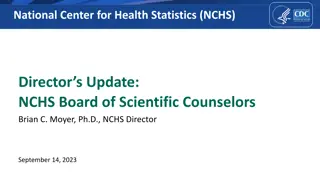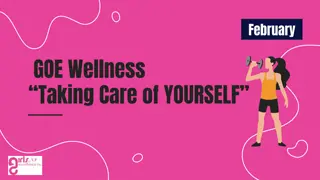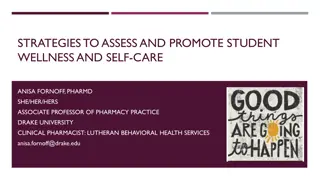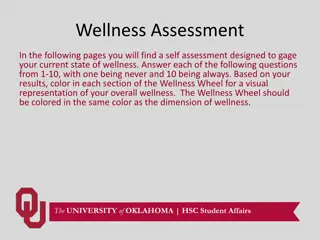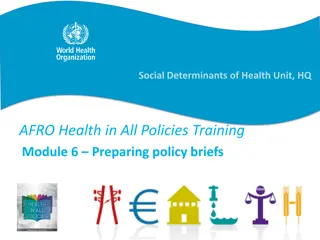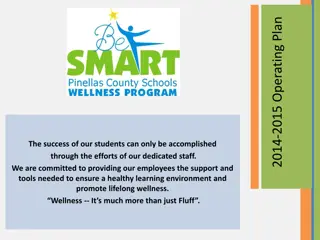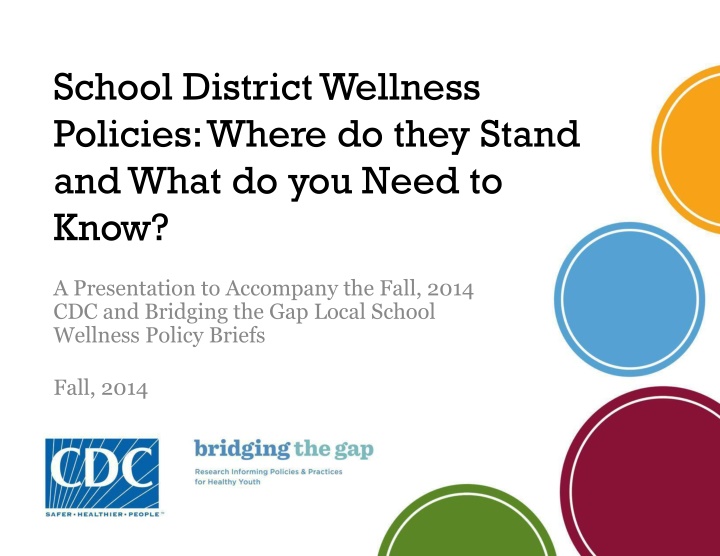
School District Wellness Policies and Implementations
Explore the development and impact of school district wellness policies, as well as key resources and strategies to enhance their effectiveness. Learn about the CDC and Bridging the Gap initiatives, along with specific methods and recommendations outlined in the Fall 2014 briefs.
Download Presentation

Please find below an Image/Link to download the presentation.
The content on the website is provided AS IS for your information and personal use only. It may not be sold, licensed, or shared on other websites without obtaining consent from the author. If you encounter any issues during the download, it is possible that the publisher has removed the file from their server.
You are allowed to download the files provided on this website for personal or commercial use, subject to the condition that they are used lawfully. All files are the property of their respective owners.
The content on the website is provided AS IS for your information and personal use only. It may not be sold, licensed, or shared on other websites without obtaining consent from the author.
E N D
Presentation Transcript
School District Wellness Policies: Where do they Stand and What do you Need to Know? A Presentation to Accompany the Fall, 2014 CDC and Bridging the Gap Local School Wellness Policy Briefs Fall, 2014
INTRODUCTION Presentation Purpose Accompany updated CDC and Bridging the Gap (BTG) local school wellness policy research briefs for the 2012-2013 school year Contains content pulled directly from briefs Serve as a communications tool for stakeholders Entire slide set Specific topic area slide set(s) Specific slide(s)/chart(s)/figure(s) Aid stakeholders in presenting content from briefs in a meaningful and impactful way
INTRODUCTION Suggested Presentation Citation FOR SLIDES, CONTENT AND/OR FIGURES FROM THIS SLIDE SET: Centers for Disease Control and Prevention and Bridging the Gap Research Program. School District Wellness Policies: Where do they Stand and What do you Need to Know?: A Presentation to Accompany the Fall, 2014 CDC and Bridging the Gap Local School Wellness Policy Briefs. 2014. Available at: http://www.cdc.gov/healthyyouth/npao/wellness.htm http://www.bridgingthegapresearch.org/research/district_w ellness_policies/.
INTRODUCTION CDC & Bridging the Gap Local Wellness Policy Briefs Developed by CDC and BTG to help stakeholders Strengthen existing policies Implement new policies Understand where wellness policies are well established and where opportunities exist 7 topic areas + methods document 3 four-page briefs 4 two-page fact sheets Available on CDC and BTG websites http://www.cdc.gov/healthyyouth/npao/wellness.htm http://www.bridgingthegapresearch.org/research/distric t_wellness_policies/
INTRODUCTION Slideshow Content Organization Each topic area contains Background information Health impact Current recommendations Actions (results) Strategies and expert recommendations Resources from CDC, USDA, Action for Healthy Kids (AFHK), and others References to literature
Fall, 2014 Methods Document for the CDC and Bridging the Gap Local School Wellness Policy Briefs Suggested citation: Bridging the Gap Research Program. Methods Document for the CDC and Bridging the Gap Local School Wellness Policy Briefs, Update for the 2012 13 School Year. Available at: http://www.cdc.gov/healthyyouth/policy/pdf/methodsforwellnesspolicybriefs.pdf.
INTRODUCTION Methods Brief Overview Purpose Provide a methodological overview for the entire series of CDC and BTG briefs Background Federal wellness policy mandate Child Nutrition and WIC Reauthorization Act of 20041 Healthy, Hunger-Free Kids Act of 20102 Bridging the Gap (BTG) program Largest, ongoing nationwide evaluation of the district wellness policy progress and opportunities School year (SY) 2006-07 through 2012-13 (for these briefs) Collection continued through the current school year Includes concomitant state laws
INTRODUCTION Methods SAMPLE DESIGN Based on 2009-10 National Center for Education Statistics Common Core of Data3 2012-13 SY data Nationally representative sample Inferences for each grade level 704 districts n=672 (95.45% response rate)
INTRODUCTION Methods POLICY COLLECTION Resources collected District policies Wellness Policy Associated administrative policies Other policies incorporated by reference within the wellness policy State laws Codified statutory (legislative) laws Codified administrative (regulatory) laws Validated against existing secondary source compilations of state laws
INTRODUCTION Methods POLICY COLLECTION Resources collected District policies Wellness Policy Associated administrative policies Other policies incorporated by reference within the wellness policy State laws Codified statutory (legislative) laws Codified administrative (regulatory) laws Validated against existing secondary source compilations of state laws National Cancer Institute s Classification of Laws Associated with School Students (CLASS) system4 National Conference of State Legislatures Childhood Obesity Legislative Tracking database5 Centers for Disease Control and Prevention s Chronic Disease State Policy Tracking System6 National Association of State Boards of Education School Health Policy Database7 Trust for America s Health annual F as in FAT8compilation
INTRODUCTION Methods POLICY CODING District policies and state laws analyzed by two trained analysts Strong policy provisions Required Specified implementation plan or strategy Banned competitive foods or met Institute of Medicine (IOM) competitive food standards Weak policy provisions Vague terms, suggestions, recommendations Contained exceptions
REFERENCES References for slide set accompanying the Methods Document for the CDC and Bridging the Gap Local School Wellness Policy Briefs, Update for the 2012 13 School Year 1. Child Nutrition and WIC Reauthorization Act, Pub. L. No. 108-265, 204, 118 Stat. 729, 780-781 (2004). Healthy, Hunger-Free Kids Act of 2010, Pub. L. No. 111-296, 204, 124 Stat. 3183, 3236-3238 (2010). National Center for Education Statistics. Common Core of Data. Available at: http://nces.ed.gov/ccd. National Cancer Institute. Classification of Laws Associated with School Students. Available at: http://class.cancer.gov/. National Conference of State Legislatures. Childhood Obesity 2011 Update of Legislative Policy Options. Available at: http://www.ncsl.org/issues- research/health/childhood-obesity-2011.aspx. Centers for Disease Control and Prevention. Chronic Disease State Policy Tracking System. Available at: http://apps.nccd.cdc.gov/CDPHPPolicySearch/Default.aspx. National Association of State Boards of Education. State School Health Policy Database. Available at: http://www.nasbe.org/healthy_schools/hs/index.php. Trust for America s Health. F as in Fat: How Obesity Threatens America s Future, 2011. Available at: http://www.healthyamericans.org/assets/files/TFAH2011FasInFat10.pdf. 2. 3. 4. 5. 6. 7. 8.
Fall, 2014 Strategies for Supporting Quality Physical Education and Physical Activity in Schools Suggested brief citation: Centers for Disease Control and Prevention and Bridging the Gap Research Program. Strategies For Supporting Quality Physical Education and Physical Activity in Schools, Update for the 2012 13 School Year. Atlanta, GA: U.S. Department of Health and Human Services; 2014.
INTRODUCTION Brief Purpose Highlights areas where policy opportunities exist, as well as areas where policies are well- established relative to physical education (PE) and physical activity (PA) Summarizes the range of actions taken by public school districts relative to PE/PA
BACKGROUND Impact on Health Physically active kids are healthier kids.1 Opportunities for physical activity programs During the school day Physical education Recess Activity breaks Outside of school hours Community use of facilities Walking or biking to school
BACKGROUND What do the experts recommend? The US Department of Health and Human Services recommends that youth engage in a minimum of 60 minutes of PA each day.2 Federal wellness policy requirement3,4 to include goals for PA Recommended policies and practices that support PA2,5-13 Requiring PE Allowing recess Supporting safe routes to school
ACTIONS What Actions have School Districts Taken? PE Requirements
ACTIONS What Actions Have School Districts Taken? PE Graduation Requirements, SY 2012 13 Only 22% of districts required specific PE graduation requirements. 76% of district policies did not include specific PE graduation requirements. Source: Bridging the Gap Research Program, 2014
ACTIONS What Actions Have School Districts Taken? Quality PE Components
ACTIONS What Actions Have School Districts Taken? PA Opportunities During the School Day
ACTIONS What Actions Have School Districts Taken? PA Opportunities Beyond the School Day
WHAT CAN YOU DO? Supporting the PE and PA Environment STATES CAN3,6-12 Provide districts with professional development and technical assistance for revising district wellness and PE and PA policies Assist districts with monitoring and reporting on the implementation of district wellness policies Partner with key organizations such as the state SHAPE America affiliate and state AFHK team to support the implementation of PE and PA policies and practices Provide professional development opportunities for district PE staff
WHAT CAN YOU DO? Supporting the PE and PA Environment SCHOOL DISTRICTS AND SCHOOLS CAN3,6-12 Create a school health council or wellness committee that includes district and community stakeholders to implement activities that align with wellness policy goals Require quality PE for all students that aligns with national and state recommendations and standards Prohibit waivers allowing students to be exempted from taking PE for participation in interscholastic and intramural sports Require that state licensed or credentialed teachers instruct all PE classes Provide ongoing professional development for PE teachers, as well as for other teachers, to incorporate PA as part of non-PE classroom exercises Offer daily recess for elementary school students Increase opportunities for children, their families, and the community to be physically active by opening up school facilities outside of school hours
RESOURCES Resources for slide set accompanying the brief Strategies For Supporting Quality Physical Education and Physical Activity in Schools, Update for the 2012 13 School Year Centers for Disease Control and Prevention. Comprehensive School Physical Activity Programs: A Guide for Schools. http://www.cdc.gov/healthyyouth/physicalactivity/cspap.htm. Centers for Disease Control and Prevention. Adolescent and School Health. Physical Education Curriculum Analysis Tool (PECAT). http://www.cdc.gov/healthyyouth/pecat/index.htm. SHAPE America. National Physical Education Standards. http://www.shapeamerica.org/standards/pe/. SHAPE America. Comprehensive School Physical Activity Programs: Helping All Students Achieve 60 Minutes of Physical Activity Each Day. http://www.shapeamerica.org/advocacy/positionstatements/pa/loader.cf m?csModule=security/getfile&pageid=4726.
RESOURCES Cont d: Resources for slide set accompanying the brief Strategies For Supporting Quality Physical Education and Physical Activity in Schools, Update for the 2012 13 School Year SHAPE America. Position Statement: Recess for Elementary School Students. http://www.shapeamerica.org/advocacy/positionstatements/pa/loade r.cfm?csModule=security/getfile&pageid=4630. US Department of Health and Human Services. Physical Activity Guidelines for Americans Midcourse Report: Strategies to Increase Physical Activity among Youth. http://www.health.gov/paguidelines/midcourse/pag-mid-course-report- final.pdf. Safe Routes. National Center for Safe Routes to School. http://www.saferoutesinfo.org. Bridging the Gap Research. School district wellness policy-related reports and materials. http://www.bridgingthegapresearch.org/research/district_wellness_policies.
REFERENCES References for slide set accompanying the brief Strategies For Supporting Quality Physical Education and Physical Activity in Schools, Update for the 2012 13 School Year 1. U.S. Department of Health and Human Services. Physical Activity Guidelines Advisory Committee Report. Washington, DC: U.S. Department of Health and Human Services; 2008. 2. Physical Activity Guidelines for Americans Midcourse Report Subcommittee of the President s Council on Fitness, Sports & Nutrition. Physical Activity Guidelines for Americans Midcourse Report: Strategies to Increase Physical Activity among Youth.Washington, DC: U.S. Department of Health and Human Services; 2012. 3. Child Nutrition and WIC Reauthorization Act, Pub. L. No. 108-265, 204, 118 Stat. 729, 780-781 (2004). 4. Healthy, Hunger-Free Kids Act of 2010, Pub. L. No. 111-296, 204, 124 Stat. 3183, 3236-3238 (2010). 5. Centers for Disease Control and Prevention. School health guidelines to promote healthy eating and physical activity. MMWR 2011;60:1 76. 6. American Academy of Pediatrics. Policy Statement: The Crucial Role of Recess in School. Pediatrics 2013;131:183-188. 7. Centers for Disease Control and Prevention. Recommended Community Strategies and Measurements to Prevent Childhood Obesity in the United States. MMWR 2009; 58.
REFERENCES References for slide set accompanying the brief Strategies For Supporting Quality Physical Education and Physical Activity in Schools, Update for the 2012 13 School Year 8. American Academy of Pediatrics. Prevention and Treatment Childhood Overweight and Obesity: Policy Tool. Available at: http://www2.aap.org/obesity/schools_1.html. 9. Institute of Medicine. Accelerating Progress in Obesity Prevention: Solving the Weight of the Nation. Washington, DC: The National Academies Press; 2012. 10.Institute of Medicine. Local Government Actions to Prevent Childhood Obesity. Washington, DC: The National Academies Press; 2009. 11. Institute of Medicine. Physical Activity and Physical Education in the School Environment. Washington, DC: The National Academies Press; 2013. 12.Institute of Medicine. Educating the Student Body: Taking Physical Activity and Physical Education to School. Washington D.C.: The National Academies Press, 2013.
Fall, 2014 Strategies to Support Recess in Elementary Schools Suggested fact sheet citation: Centers for Disease Control and Prevention and Bridging the Gap Research Program. Strategies for Supporting Recess in Elementary Schools, Update for the 2012 13 School Year. Atlanta, GA: U.S. Department of Health and Human Services; 2014.
INTRODUCTION Brief Purpose Highlights areas where school recess policy opportunities exist, and where policies are well-established Summarizes actions taken by school districts and states relative to recess
BACKGROUND Impact on Health Recess Provides students with a break from their structured school day Can improve children s physical, social, and emotional well-being1,2 Can enhance learning3 Helps children meet the goal of 60 minutes of PA per day4
BACKGROUND What do the Experts Recommend? National organizations recommend that districts provide at least 20 minutes of daily recess for all students in elementary schools.2,5-9
ACTIONS What Actions Have School Districts Taken? Recess Policies in Elementary Schools
WHAT CAN YOU DO? Encouraging Daily Recess STATES CAN2,4-9 Develop and adopt daily recess policies, and monitor district and school implementation Work with districts to upgrade and maintain PA equipment and facilities that are used for recess Provide districts with training and technical assistance for aligning wellness and recess policies with national recommendations Assist districts with monitoring and reporting on the implementation of district wellness policies
WHAT CAN YOU DO? Encouraging Daily Recess SCHOOL DISTRICTS AND SCHOOLS CAN2,4-9 Create a school health council that includes district and community stakeholders to implement, monitor, and evaluate activities that align with wellness policy goals Review and revise the district wellness policy to align with national recess recommendations Assist schools with implementing the policy Make the district wellness policy available to parents and other stakeholders (e.g., district website) Involve stakeholders in reviewing and revising district wellness and recess policies Offer daily recess for elementary school students in addition to PE Maintain safe and age-appropriate equipment for students to use during recess Ensure that well-trained supervisors are present during recess
RESOURCES Resources for slide set accompanying the brief Strategies for Supporting Recess in Elementary Schools, Update for the 2012 13 School Year U.S. Department of Health and Human Services. Physical Activity Guidelines for Americans Midcourse Report: Strategies to Increase Physical Activity among Youth. http://www.health.gov/paguidelines/midcourse/pag-mid-course-report-final.pdf. USDA Food and Nutrition Service. Local School Wellness Policy. http://www.fns.usda.gov/tn/local-school-wellness-policy. USDA Healthy Meals Resource System. School Nutrition Environment and Wellness Resources. http://healthymeals.nal.usda.gov/school-wellness-resources. Bridging the Gap Research. School district wellness policy-related reports and materials. http://www.bridgingthegapresearch.org/research/district_wellness_policies.
RESOURCES Cont d: Resources for slide set accompanying the brief Strategies for Supporting Recess in Elementary Schools, Update for the 2012 13 School Year SHAPE America. Position Statement: Recess for Elementary School Students. http://www.shapeamerica.org/advocacy/positionstatements/pa/loader.cfm? csModule=security/getfile&pageid=4630. International Play Association. Promoting Recess. http://www.ipausa.org/recess_pages/promoting_recess.html . American Academy of Pediatrics. Policy Statement: The Crucial Role of Recess in School. http://pediatrics.aappublications.org/content/131/1/183.full.pdf.
REFERENCES References for slide set accompanying the brief Strategies for Supporting Recess in Elementary Schools, Update for the 2012 13 School Year 1. Ramstetter CL, Murray R, Garner AS. The crucial role of recess in schools. Journal of School Health 2010;80:517-526. 2. American Academy of Pediatrics. Policy Statement: The Crucial Role of Recess in School. Pediatrics 2013;131:183-188. 3. Centers for Disease Control and Prevention. The Association between school-based physical activity, including physical education, and academic performance. Atlanta, GA: U.S. Department of Health and Human Services; 2010. 4. U.S. Department of Health and Human Services. 2008 Physical Activity Guidelines for Americans. 5. Centers for Disease Control and Prevention. School health guidelines to promote healthy eating and physical activity. MMWR 2011;60:1 76. 6. American Academy of Pediatrics. Prevention and Treatment Childhood Overweight and Obesity: Policy Tool. Available at: http://www2.aap.org/obesity/schools_1.html. 7. Institute of Medicine.Accelerating Progress in Obesity Prevention: Solving the Weight of the Nation. Washington, DC: The National Academies Press; 2012. 8. Institute of Medicine. Educating the Student Body: Taking Physical Activity and Physical Education to School. Washington, DC: The National Academies Press; 2013. 9. SHAPE America. Position Statement: Recess for Elementary School Students. Available at: http://www.shapeamerica.org/advocacy/positionstatements/pa/loader.cfm?csModule=se curity/getfile&pageid=4630.
Fall, 2014 Strategies for Creating Supportive School Nutrition Environments Suggested brief citation: Centers for Disease Control and Prevention and Bridging the Gap Research Program. Strategies for Creating Supportive School Nutrition Environments, Update for the 2012 13 School Year. Atlanta, GA: U.S. Department of Health and Human Services; 2014.
INTRODUCTION Brief Purpose Highlights areas where policy opportunities exist, as well as areas where policies are well-established relative to Nutrition standards for competitive foods and beverages Marketing and promotion of foods and beverages Access to free drinking water Nutrition education Farm to School programs and school gardens Nutrition-related training for school personnel Strategies to increase participation in school meals
BACKGROUND Impact on Health Good nutrition is vital for optimal health.1,2 Schools have the potential to shape healthy behaviors, including eating habits. A supportive nutrition environment provides Access to healthy foods in all venues Consistent messages about healthy eating Opportunities for students to learn about healthy eating Improving nutrition can improve physical health and academic achievement. 3-5
BACKGROUND What Do the Experts Recommend? National organizations recommend that schools3,4,6-8 Provide healthy and appealing foods Limit marketing of low-nutrient, high calorie foods Implement Farm to School programs Provide nutrition education
ACTIONS What Actions Have School Districts Taken? Nutrition standards for competitive food and beverages Marketing and promotion of foods and beverages Access to free drinking water on school campuses Nutrition education for students Farm to School programs and school gardens Nutrition-related training for school personnel Policy strategies to increase participation in school meals
ACTIONS What Actions Have School Districts Taken? Nutrition Standards for Competitive Foods and Beverages
ACTIONS What Actions Have School Districts Taken? Nutrition Standards for Competitive Foods and Beverages
ACTIONS What Actions Have School Districts Taken? Nutrition Standards for Competitive Foods and Beverages
ACTIONS What Actions Have School Districts Taken? Marketing and Promotion of Foods and Beverages, SY 2012 13 13% of districts prohibited all forms of advertising and promotion of unhealthful choices. 5% of districts promoted marketing of healthful items or used strategies to encourage healthy choices. Source: Bridging the Gap Research Program, 2014
ACTIONS What Actions Have School Districts Taken? Access to Free Drinking Water on School Campuses, SY 2012 13 10% of districts required free access to drinking water throughout the school day. 9% of districts required free access to drinking water during school meals. Source: Bridging the Gap Research Program, 2014
ACTIONS What Actions Have School Districts Taken? Nutrition Education for Students, SY 2012 13 52% of districts required skill-based nutrition education. 37% of districts required a nutrition education curriculum be provided for each grade level. Less than 1% of district policies required a specific number of nutrition education courses or contact hours. Source: Bridging the Gap Research Program, 2014
ACTIONS What Actions Have School Districts Taken? Farm to School Programs and School Gardens, SY 2012 13 Approximately 1% of district policies required Farm to School programs or locally-grown food to be purchased for school meals. 1% of districts required a school garden. Source: Bridging the Gap Research Program, 2014
ACTIONS What Actions Have School Districts Taken? Nutrition-Related Training for School Personnel, SY 2012 13 11% of districts required nutrition education training or professional development for all district staff. 8% of districts required nutrition education training or professional development for food service staff. Source: Bridging the Gap Research Program, 2014



